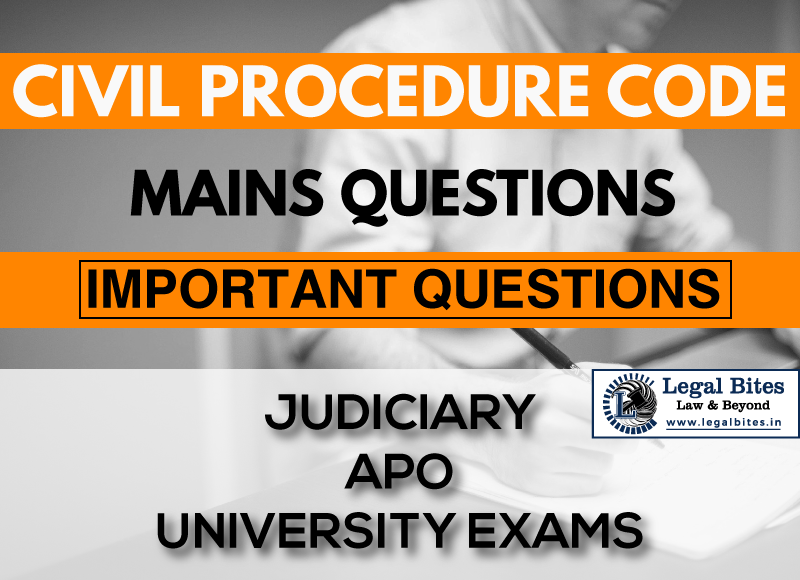What claims can be joined for recovery of immovable property?
Find the answer to the mains question only on Legal Bites.

Question: What claims can be joined for recovery of immovable property? Find the answer to the mains question only on Legal Bites. [What claims can be joined for recovery of immovable property?]AnswerOrder 2 Rule 4 of the Code of Civil Procedure provides as below: “Only certain claims to be joined for recovery of immovable property.- No cause of action shall, unless with the leave of the court, be joined with a suit for the recovery of immovable property, except— (a) claims for...
Question: What claims can be joined for recovery of immovable property?
Find the answer to the mains question only on Legal Bites. [What claims can be joined for recovery of immovable property?]
Answer
Order 2 Rule 4 of the Code of Civil Procedure provides as below:
“Only certain claims to be joined for recovery of immovable property.- No cause of action shall, unless with the leave of the court, be joined with a suit for the recovery of immovable property, except—
(a) claims for mesne profits or arrears of rent in respect of the property claimed or any part thereof;
(b) claims for damages for breach of any contract under which the property or any part thereof is held; and
(C) claims in which the relief sought is based on the same cause of action:
Provided that nothing in this rule shall be deemed to prevent any party in a suit for foreclosure or redemption from asking to be put into possession of the mortgaged property.”
Let's examine each provision in detail:
(a) Claims for mesne profits or arrears of rent: A plaintiff can join a claim for mesne profits (profits derived from the property while it was wrongfully withheld by the defendant) or arrears of rent in the same suit for the recovery of immovable property. This allows the plaintiff to seek not only the recovery of the property but also compensation for the use and occupation of the property or unpaid rent.
(b) Claims for damages for breach of contract: If the immovable property is held under a contract, the plaintiff can join a claim for damages caused by the defendant's breach of that contract. For example, if the defendant has violated the terms of a lease or agreement regarding the property, the plaintiff can seek damages arising from that breach in the same suit for the recovery of the property.
(c) Claims based on the same cause of action: The rule also permits the joinder of claims in which the relief sought is based on the same cause of action. This means that if the claims arise from the same set of facts or legal basis, they can be joined in one suit. For instance, if multiple parties have a right to recover the same immovable property based on a common cause of action, such as co-ownership or an inheritance dispute, they can unite their claims in a single suit.
Additionally, the rule includes a proviso stating that nothing in this rule shall prevent any party in a suit for foreclosure or redemption from seeking possession of the mortgaged property. This exception recognizes the specific nature of foreclosure or redemption suits, where the party seeking to enforce a mortgage may request possession of the property as part of the relief sought.
It's important to note that the joinder of claims in a suit for the recovery of immovable property requires the leave (permission) of the court, except in cases falling under the specified categories mentioned in the rule. The court has the discretion to grant or deny leave to join additional claims based on the specific circumstances of the case.
Important Mains Questions Series for Judiciary, APO & University Exams
- CPC Mains Questions Series: Important Questions Part – I of X
- CPC Mains Questions Series: Important Questions Part – II of X
- CPC Mains Questions Series: Important Questions Part – III of X
- CPC Mains Questions Series: Important Questions Part – IV of X
- CPC Mains Questions Series: Important Questions Part – V of X
- CPC Mains Questions Series: Important Questions Part – VI of X
- CPC Mains Questions Series: Important Questions Part – VII of X
- CPC Mains Questions Series: Important Questions Part – VIII of X
- CPC Mains Questions Series: Important Questions Part – IX of X
- CPC Mains Questions Series: Important Questions Part – X of X

Mayank Shekhar
Mayank is an alumnus of the prestigious Faculty of Law, Delhi University. Under his leadership, Legal Bites has been researching and developing resources through blogging, educational resources, competitions, and seminars.
